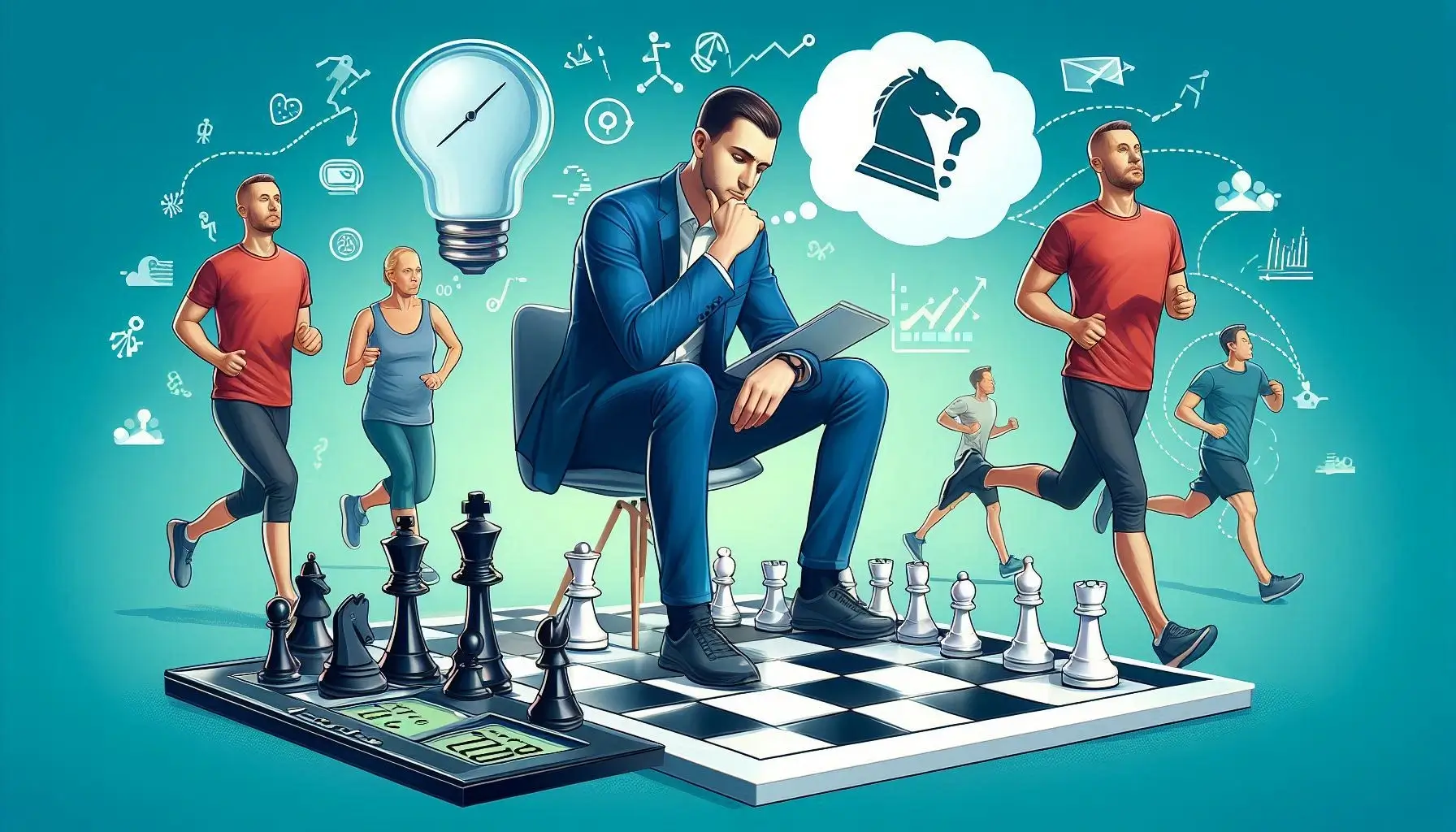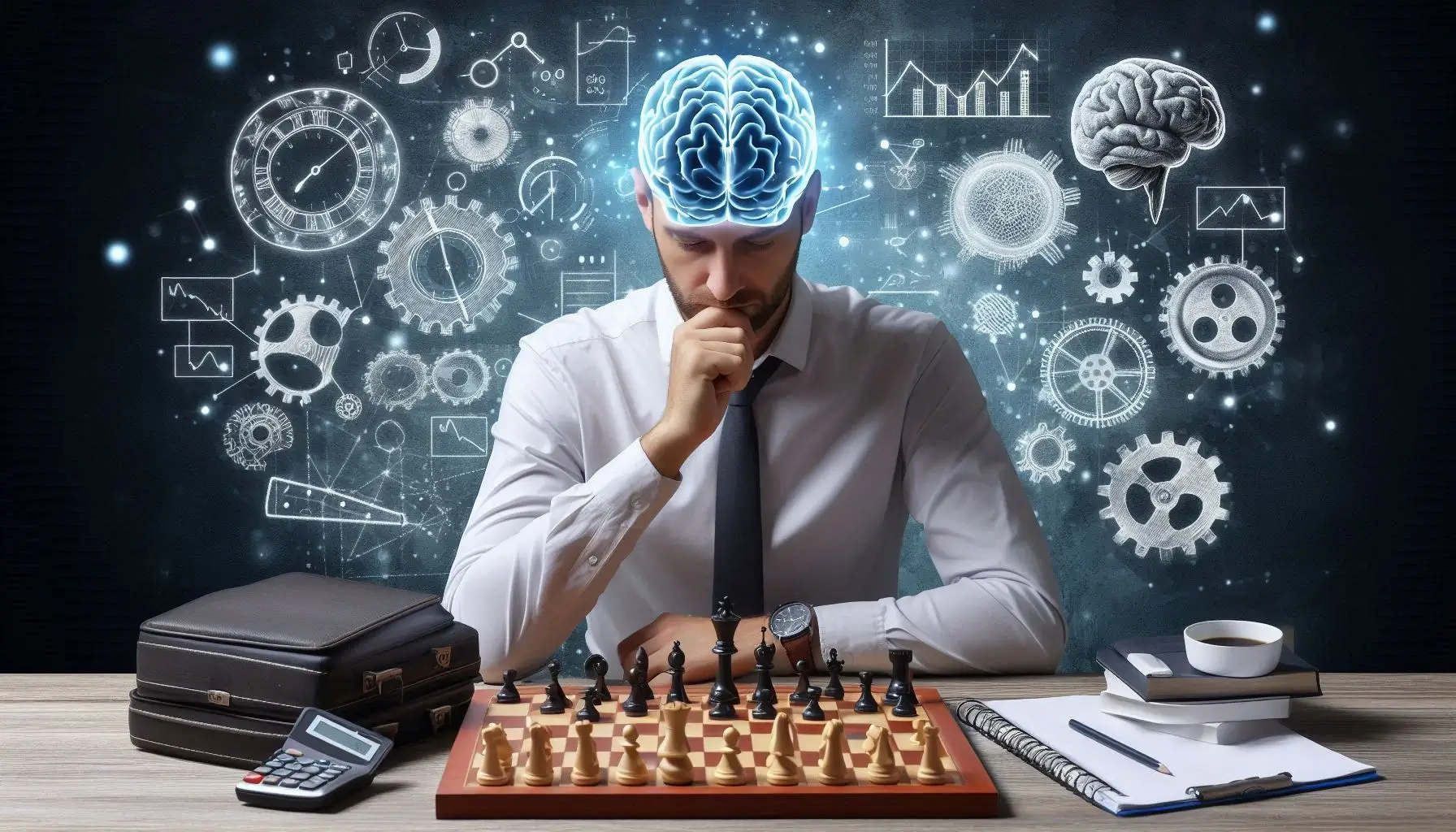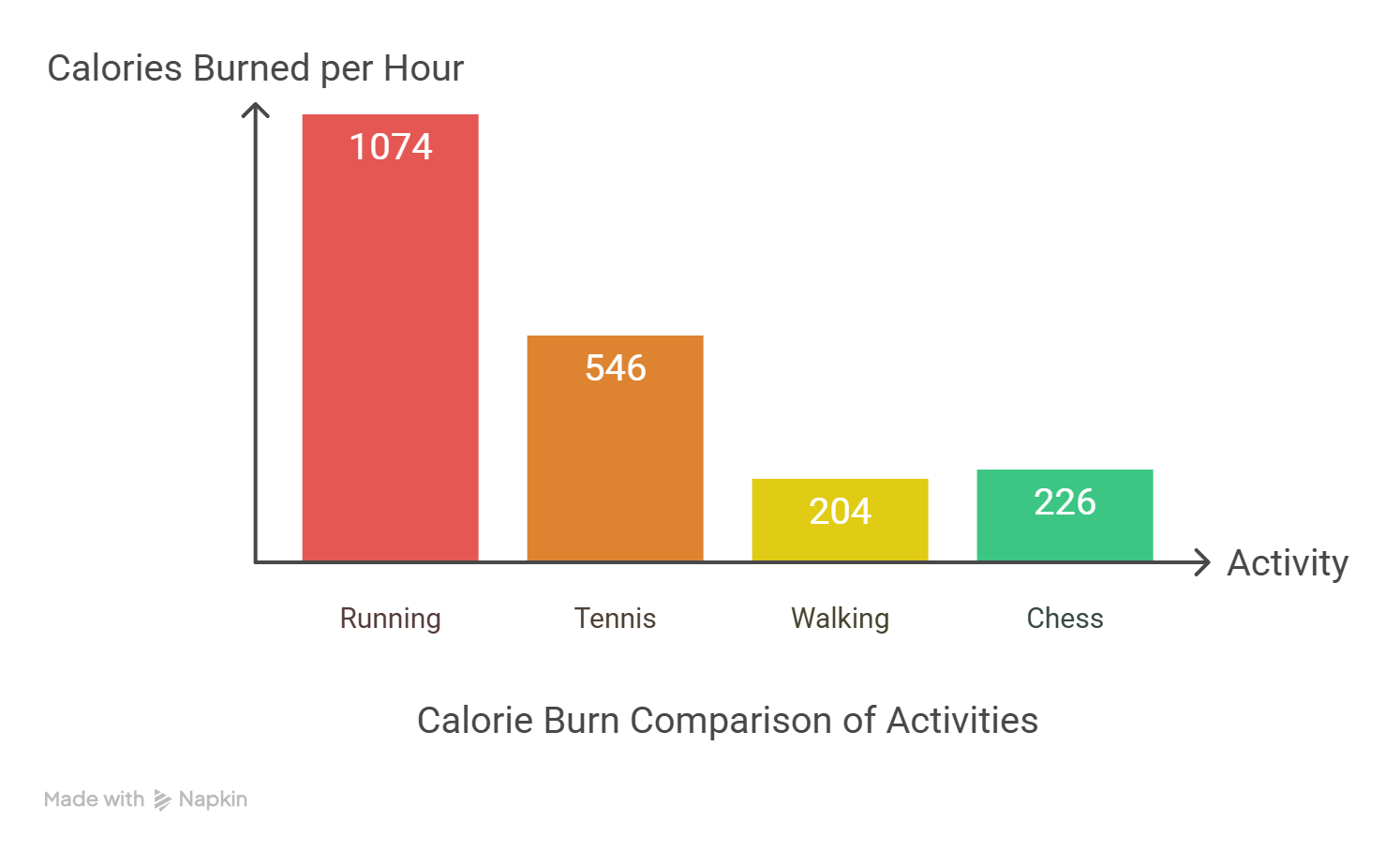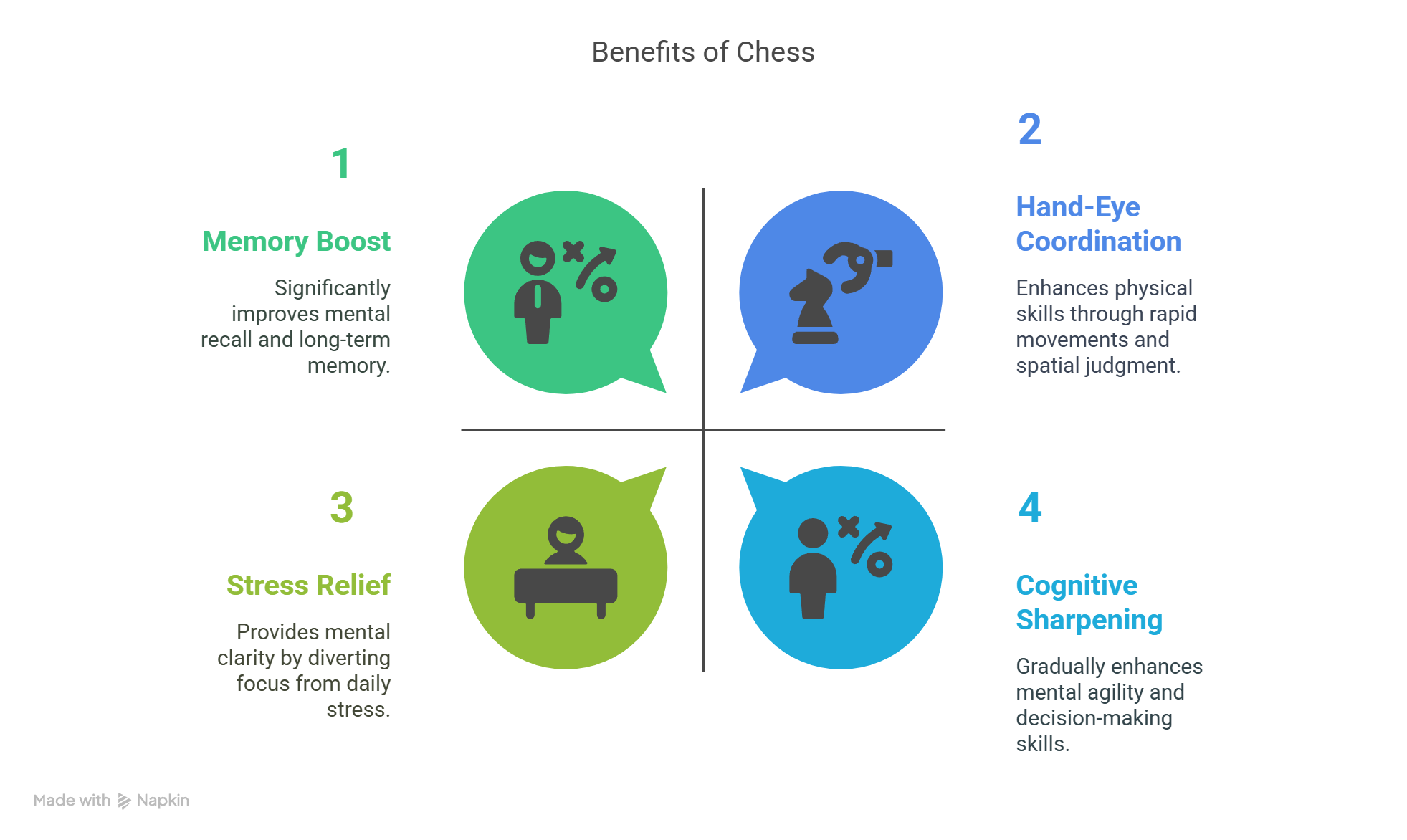Introduction
At the 2018 Chess Olympiad, some of the world’s top grandmasters emerged from their chairs looking like they’d just run a marathon. And in a way, they had. Fabiano Caruana reportedly lost over 10 pounds during a high-stakes tournament—not from running laps, but from sitting still and thinking. It raises a surprising question right from the start: Does chess burn calories?
It sounds implausible at first. We’re trained to associate calorie burn with sweat-drenched workouts and thumping playlists, not knights, bishops, and 64 silent squares. But as it turns out, chess is more physically taxing than its quiet demeanor suggests.
Which brings us to the checkmate of curiosity: Does chess burn calories? Let’s find out.

Mental Gymnastics, Real Burn: The Science
Does Chess Burn Calories? Calorie Range Breakdown
Yes, chess burns calories – and the numbers are more impressive than you might guess. Research estimates that players can torch 132 to 320 calories per hour (OCF Chess), depending on the intensity of the match and the individual behind the board.
Variables like weight, age, baseline metabolism, and stress response all play a role in the burn. A casual weekend player might stay closer to the lower end, while a tournament-trained tactician locked in a four-hour blitz of Sicilian Defense and psychological warfare might clock in at the top.
Put another way? A solid hour of chess could cost you as much energy as a brisk walk – or half a session on the treadmill, minus the playlist.
Many wonder — is chess a sport? The physical and mental strain top players experience suggests it just might be.
Does Chess Burn Calories During Tournament Mode?
Now turn up the dial. Professional chess players, particularly during tournament play, enter a mental crucible that can push their bodies into overdrive. Picture nine hours of continuous, high-stakes calculation – with adrenaline pumping, cortisol spiking, and a brain running hotter than a laptop with too many tabs open.
The result? Up to 1,188 calories burned in a single tournament day. That’s nearly the equivalent of a 10K run – without taking a single step.
The message is clear: In elite chess, the brain becomes a metabolic engine, converting pressure into performance – and energy into focus.
Why Does Chess Burn Calories? The Brain Role
Cognitive Load & Brain Activation
Beneath the quiet surface of a chessboard lies a riot of neurological activity. Every move in chess demands an orchestra of cognitive functions: working memory, pattern recognition, strategic foresight, and emotional regulation. From anticipating an opponent’s next five moves to calculating endgame scenarios, the brain lights up like a city at night.
Functional MRI scans show heightened activity in the prefrontal cortex, hippocampus, and parietal lobes – areas linked to planning, memory, and spatial reasoning. It’s not just thinking hard. It’s a full-brain workout with every rook shuffle and queen sacrifice.
In short? Chess players don’t just play the board. They play themselves – constantly recalibrating under pressure, mining memory for past positions, and engaging in a form of intellectual weightlifting that taxes the system.

Physiological Response
But it doesn’t stop at the skull. The brain may be the command center, but its high-octane performance comes with physical consequences. Sustained mental strain triggers the sympathetic nervous system – the same fight-or-flight response activated during a crisis.
Heart rate increases. Breathing quickens. Muscles may even tense. All without leaving the chair. The body responds as if preparing for battle, because in a way, it is.
Then there’s cortisol, the infamous stress hormone. Elevated levels during tournament play can jack up the body’s metabolic rate, prompting higher calorie burn even in the absence of motion. It’s the quiet metabolic kick you never see coming – the hidden cost of high-level thinking under stress. As HobbyFAQs highlights, this physiological reaction helps explain why chess can lead to meaningful energy expenditure, even though it’s technically a sedentary activity.
Does Chess Burn Calories Compared to Other Activities?
Activity Chart
Activity | Calories Burned (per hour) |
Running (8 mph) | 1,074 |
Tennis | 546 |
Walking (3 mph) | 204 |
Chess | 132–320 |

The numbers are illuminating. Chess doesn’t break the top of the chart, but for a seated activity? It punches way above its weight. The brain consumes a large amount of energy, especially during intense concentration. It’s no wonder some people ask, does chess raise your IQ along with your heart rate?
What Makes Chess Unique
Where physical sports tax the body first and the mind second, chess inverts the equation. It’s mental exhaustion masquerading as physical stillness, a battle waged in the mind that reverberates through the body.
The fatigue felt after hours of chess isn’t imaginary. It’s the aftermath of cortisol surges, neural overclocking, and energy reserves redirected to cerebral performance. Unlike physical fatigue, which is muscle-deep, this is exhaustion that hums beneath the skin – mental, hormonal, metabolic.
Chess doesn’t give you sore quads. It gives you a worn-out mind and a calorie count to match.
If you’re playing longer, more focused games, you’ll burn more energy. Want to push yourself further? Learn how to get better at chess.
Beyond the Burn: Other Health Perks of Chess
The benefits of chess don’t end at the metabolic margin. While it’s not a fitness fix-all, it’s undeniably a brain-boosting powerhouse. As outlined in a comprehensive piece by DoveMed, chess contributes to overall mental well-being in ways that go far beyond calorie counts. Here’s what else it brings to the wellness table:
- Memory Boost
Regular play sharpens short-term recall and strengthens long-term memory, especially when tracking openings, positions, and past games. - Stress Relief
Despite the intensity, chess offers an immersive escape—channeling focus away from daily anxiety and into the clarity of the board. - Cognitive Sharpening
Strategic planning, problem-solving, and creative thinking all get a workout. Over time, players often report improved mental agility and quicker decision-making.
Hand-Eye Coordination
Especially in blitz or speed formats, the physical act of rapid movement combined with spatial judgment hones fine motor skills and reaction time.

Can Chess Burn Calories Enough Replace the Gym?
Let’s be real: chess alone won’t get you fit. It burns calories, yes – but it won’t build cardiovascular strength, muscle tone, or endurance. There’s no substitute for sweat when it comes to physical fitness.
But here’s the twist: chess complements physical exercise in a way few pastimes can. The two together – body training and brain training – offer a synergy that supports total well-being.
Want sharper focus during your workout? Play chess. Need to manage stress and recover mentally after a tough session at the gym? Sit down with the board.
Mind + muscle = true checkmate health.
Conclusion
So, does chess burn calories? Absolutely. But not in the way a treadmill does. It’s not about movement – it’s about mental endurance, strategic strain, and the kind of deep focus that quietly demands energy.
In the end, the true value of chess lies in its dual identity: a sport of the mind and a subtle contributor to physical metabolism. It won’t replace your HIIT sessions or yoga flows, but it will keep your brain razor-sharp, your stress levels lower, and yes, your calorie count ticking ever upward – even in stillness.
Make it part of your wellness toolkit. Pair it with physical exercise, proper rest, and good nutrition, and you’re not just playing the board – you’re playing the long game of a healthier, more balanced life.
If you’re curious about learning more or want personalized training, feel free to contact me.
Checkmate, burnout.
FAQ
1. Can playing chess help me lose weight?
Not on its own – but it can contribute to calorie burn, especially during intense or extended play. Combine it with physical exercise and a healthy diet for best results.
2. How many calories does a typical chess game burn?
A standard 30-minute game may burn around 138 calories. Hour-long sessions can range from 132 to 320 calories, depending on intensity and individual factors.
3. Why does mental effort burn calories?
Your brain is an energy-hungry organ. Strategic thinking, memory recall, and problem-solving increase neural activity, which in turn raises your metabolic rate slightly – even while sitting still.
4. Do professional chess players really burn thousands of calories during tournaments?
Yes. Top players can burn up to 6,000 calories in a day during multi-hour tournaments, thanks to extreme mental strain and stress responses like elevated cortisol levels.
5. Is chess good for mental health?
Absolutely. Chess can help improve focus, reduce stress, enhance memory, and even promote mindfulness by drawing your attention fully into the moment.
